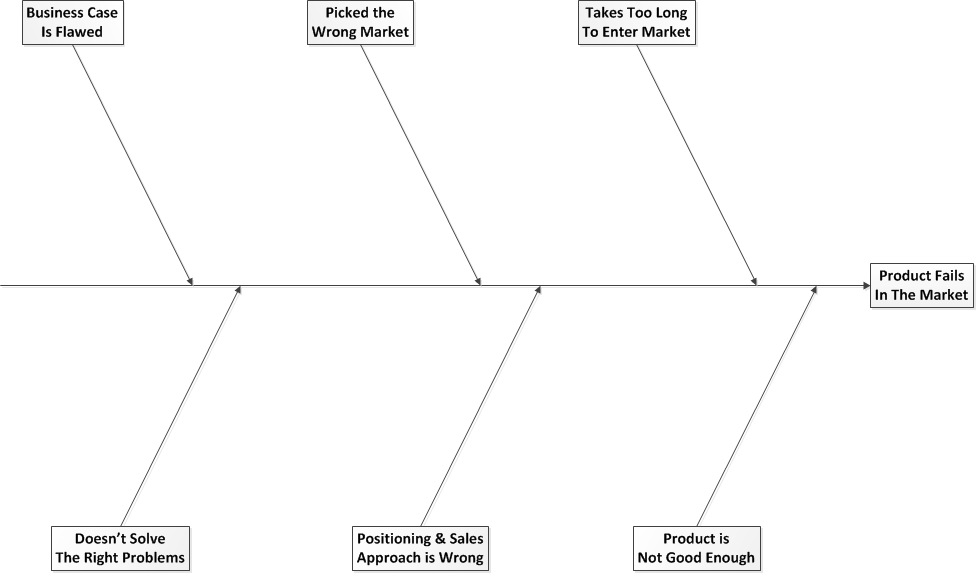It doesn’t just require the best business idea to rock the business side of things. Even when you have a great problem solving product with a wide market gamut, you will sometimes fall short of good teams and good dynamics between different business functions. In the year 2011, product failure was unfortunately at a staggering height of 48% (source), because of reasons like poor coordination between functions like finance, sales, marketing and operations. At different stages of a business, things get more complex and it gets tougher than usual to maintain the same level of growth and make sure they every operation runs in parallel with business objectives.

Constructing a solution for a trivial problem
The crowd doesn’t care about your product and it never will. They only happen to like a product if it solves a critical problem, saves them enormous amounts of time and helps them achieve a purpose soon than they could have without the product. Look into your product and make sure you are not solving something which is not being asked to solve, which isn’t such a big deal. Try to hit areas which require some solution as soon as possible.
- Conduct sessions where you can speak to your users and solve the problems which create a difference in their operations.
- Prioritise items as per their impact quotient and try to untangle the unaddressed. If that problem is already solved, you can find a way to solve it in a better way.
- Show them hope on their being an alternative for this problem. This will at least build trust towards your brand.
Making assumptions about the customers
Your product teams might end up making something entirely offbeat if they are served with assumptions or made to work on some uncultivated facts. It will probably point them in the wrong direction.
Instead, continuously involve teams in seeking external validation from the end users of the product. Imbibing a culture of gathering external feedback will help you and your product and business teams to channel their efforts and measure success in the appropriate direction which will help your product and business in the longer run.
Diverging from the roadmap or improper roadmapping
There is a product vision and there is a defined path for product teams, a lot of things get figured out on the fly but 60% of the roadmap is supposed to be figured out before finding the right people to fit in the team. The ideal roadmap is communicated strategically to the entire team and it resonates with the bigger picture the product stakeholders re looking at and trying to maintain. It ultimately keeps on making the bigger picture clearer and clearer as the team moves ahead. What do the core elements of a blueprint look like:
- In what ways does the product align against the organisational goals.
- What are the key performance indicators and how do they fit in the organisation’s vision?
- What goals is the product achieving for the customer and is it in sync with the organisational vision?
- What is the customer’s journey is utilising the product or the feature?
- What is the adoption strategy, how would the product penetrate the market and address problems which have never been addressed.
- What are the fundamentals of making decisions for the product and the organisation, is it in sync with what is the organisation’s goal.
Unclear value proposition
You value proposition isn’t understood by your customers and maybe even by your products and business teams.Make it clear to them as to what are you bringing on the table and how is it going to change things for some particular segment of the market or some business in specific. If the teams don’t understand the product’s value or they are not sold on some ideas, try to bring them on the same page first.
Help your customers in finding the value of the product they are using, until they realise that it will be hard to keep them using the product for a long time. They will someday realise it’s not worth the price or they learning curve and they will eventually be unsold on the product, either they will switch to a better product or they won’t use any product at all.
Don’t go all in for launches
Going all gaga over launches and diverting your entire product team to focus on the launch mechanics is a big mistake. It’s okay if you are hitting the market in a month, dedicate a team to figure out the logistics of it and make necessary action steps, whether it may be in terms of strategy or finances or the distribution strategy. This is supposed to make sure things go very smoothly.
What teams happen to do instead is, they spend all the energy and time and resources in figuring out the launch logistics and it affects their operations. Launch is a one time storm, which doesn’t stay for more than 2 days, everything gets back to normal within 72 hours, so diverting energy is fine and required but what shouldn’t be done is allocating the entire product division to go all heads down with the launch.
Undue attention on design
Design is considered a very crucial factor in every product and it does drive business. Until and unless you can resonate with your audience on the artistic level, you cannot resonate with their problems. Try investing time in hitting the right design language for your customers.
Undue attention to design will get you on the bad books of customers, A/B test things which make sense and make sure they are in sync with what is expected on the product side of it.
Not communicating to your customers
You need to maintain consistent touch with your customers, they are crucial to your existence in the market and listening to them and communicating with them on a regular basis is something you need to do take very strictly. If they happen to be on a different page, you need to show them what’s in there for them, what’s the product’s overall vision and what is the product aiming to achieve here. May it be post sale communication or your communication team putting in the right efforts to make them feel like they always have your support.
Don’t beta down everything
What generally SaaS products do is they want to beta down everything. If 70% of your product is in the beta stages, extend the launch and work hard to push 10 more percent of the features to a stable build. If you beta everything, you will be piled up big time.
Jott, an online voice-to-text to-do-list service was kept in beta for nearly more than 2 years and they built up a lot of beta users as well as early adopters, what happened when they tried to launch? the service couldn't host so many beta users all at once. It crashed and an apology had to be issued to the users across the blackberry user segment back in the days.
Lack of a good business model
The business model has evolved a lot, especially in the SaaS industry and also because of the inception of SaaS. Most entrepreneurs assume don’t work around their business model and try to find loopholes and revenue making opportunities. In some cases, they lack the belief that they can churn out a passive income from the same product to fuel their operations. The lean startup model has been around since a long time. Business is not always out of the end consumers, business may be lying across your vendors or partners, you just have to look through things the right way. It’s time to re-evaluate your business model and make sure you aren’t losing out on good cash cows and you aren’t spending more to acquire customers than you are eventually making.
You can also check out how a good delivery pipeline looks like and what does it take to modernise your build pipeline.
Takeaway
SaaS businesses need to take care of a lot of things to make sure everything is in sync and they are not headed in the wrong direction. Making the aforementioned mistakes is very common and teams find it hard to cope with but at the end of the day, they have to be thought through very holistically. You shouldn’t start something without calculating how will you make it sustain.
Subscribe
Related Blogs
Exploring Drupal's Single Directory Components: A Game-Changer for Developers

Web development thrives on efficiency and organisation, and Drupal, our favourite CMS, is here to amp that up with its…
7 Quick Steps to Create API Documentation Using Postman

If you work with API , you are likely already familiar with Postman, the beloved REST Client trusted by countless…
What is Product Engineering Life Cycle?

Imagine constructing a house without a blueprint or a set of plans. It will be challenging to estimate the cost and labor…




